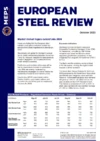New price surcharges blur carbon steel market picture
European commodity carbon steel prices continued to fall, into early October. Reduced iron ore and scrap costs were translated into decreased transaction values. However, a recovery in the raw materials market slowed the downward momentum and prices for several steel products started to move upwards.
Attention then rapidly switched to energy. Soaring gas and electricity prices resulted in significant cost hikes, particularly for electric arc-route steelmakers. Several steel producers announced their intention to implement new surcharges, to cover escalating energy and other costs. This ran counter to the general market trend and, consequently, blurred decision making.
In addition to energy, these proposals cover surcharges for transport, scrap, sustainability and green steel. Other mills have adopted the traditional method of raising offered prices to cover increased costs.
The principle of surcharges is well established in certain steel sectors, notably the stainless market. They usually relate to alloying elements, traded on world markets and subject to constant fluctuation. Contracts are typically agreed with a basis price, fixed at time of order, plus an alloy surcharge, applicable at time of delivery. These can often move in opposite directions.
Individual producers calculate the ‘extra’ each month, based on published alloy indices, and advise customers accordingly. The surcharge is subsequently applied to deliveries in the following month. The same pricing structure is included in distributors’ sales invoices during the same period.
Previous efforts to introduce surcharges in the carbon steel industry met with very little success. Generally, these were attempts to impose immediate charges on existing contracts, to cover rapid rises in the cost of raw materials, such as scrap. These are unlike dimension and grade extras, which are incorporated in the price agreed at the time of order.
Currently, mills are proposing surcharges on new orders only. This is a less aggressive approach and avoids breaking agreements. However, it is far from clear whether new orders include those placed against existing framework contracts, such as exist within the auto sector. The inflated prices may be shouldered by a limited proportion of buyers. It also raises the issue of today’s high costs being incorporated in future supplies, when the market could look very different.
No two mills have exactly the same cost basis. The blast furnace route is currently less affected than EAF steelmaking, by high electricity rates. This makes a uniform approach, even within a single group, difficult to implement.
Ultimately, the effective price is key. Most buyers will look at the bottom line, regardless of how it is calculated, and place orders accordingly. Deals for niche products may be able to reflect these additional costs. In contrast, with or without surcharges, prices for commodity items will inevitably tend towards the market value.

Source:
European Steel Review
The MEPS European Steel Review is an informative, concise and easy-to-use monthly publication, offering unique professional insight into European carbon steel prices.
Go to productRequest a free publication





